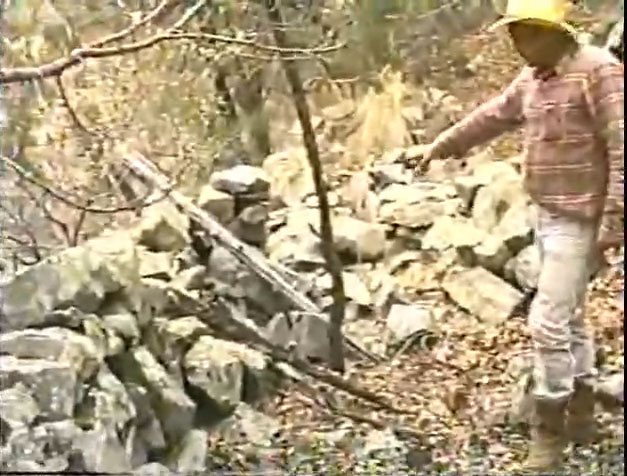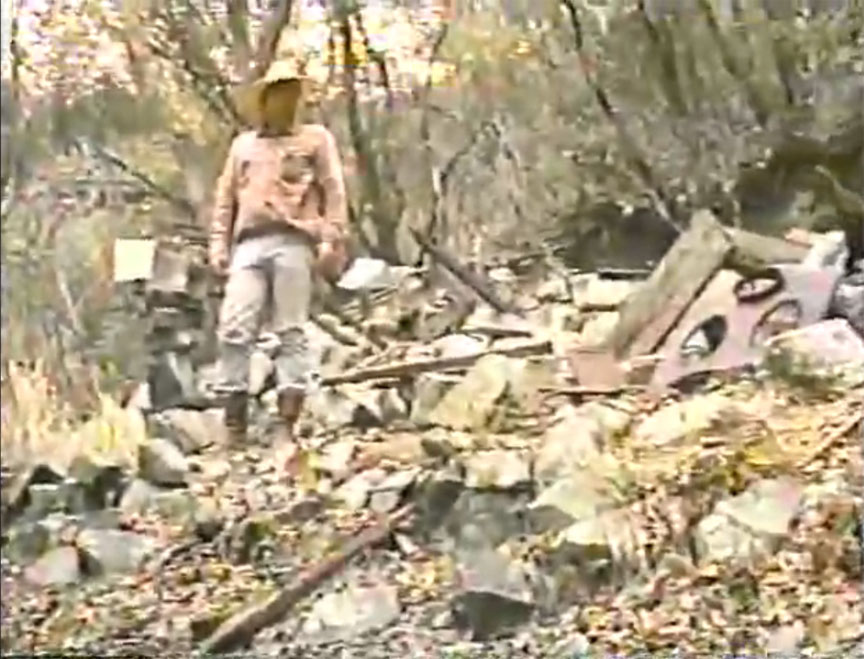|
Entertainment Magazine: Tucson: The Lost City Explore the ancient Lost City in the Catalinas with Prsopector Flint Carter
The connection between the Lost City and the Lost Iron Door Mine are intertwined with folklore and history. Local prospector William "Flint" Carter has spent more than four decades exploring and mining the Santa Catalina Mountains. During those years he has documented ancient artifacts, structures, and believes he located the fabled Mine with the Iron Door.
Photo: Tucson prospector Flint Carter points out the walls to the suspected Lost City of The Santa Catalina Mountains, found deep within the mountain range. According to the local legends, the Spaniards prospected lucrative gold mines in the Catalinas during the early 1700's while Father Kino was pioneering the New World and creating new missions, like the San Xavier del Bac, located south of Tucson, Arizona. During this period the legends assert, the Spanish Jesuits forced the local natives into slavery to mine the gold from the Catalinas. The details vary with the different versions, but the basic theme is the same. The legends describe a small community and church that was built deep in the Catalina mountains to support the imprisoned natives who were forced to work the nearby mine- the famous Iron Door Mine. The Jesuits were later expelled from the area and its exact location became lost in time. All that remains in this area today are scattered stone ruins, artifacts, mine shafts and debris from later years.
Photo: Flint Carter walks among the old mining debris and artifacts found in the Santa Catalina Mountains. Kino's mission to convert the natives; reports rich treasuresKino came to the Americas in support of his Breve Relación of May 3, 1698. The royal cédula, issued by the King of Spain, was used to convert the natives and promise that they would not be forced to work in the mines if they converted to Christianity.
As Kino made this way up through present-day Arizona, called Pimeria Alta, in 1702, he described in his diaries about
No documentation implicates either Kino or any Jesuits missionaries, but Kino's friendship with Lt. Juan Bautista de Escalante, the local military governor of Sonora, helped Kino round up renegade natives who were attacking the Spanish and Mexican settlers. Some of the legends about the Iron Door Mine have referred to the mine as the Lost Escalante Mine. 3 In one of Kino's letters to Escalante, he requests Escalante's assistance to route out rebellious Apache Indians:
The mine was said to be active until the Jesuits were expelled in 1767. It wasn't until 1880 that the lost pueblo, called The Nine Mile City, was rediscovered. An account by two prospectors described an exploration into the Catalina mountains for the express purpose to find the Nueva Mia Ciudad and the mine with the iron door. 5 Over ten years later, in article in the February 17, 1891 edition of the Tombstone Prospector reported:
Lost City Links
Footnotes: These links lead to the text of the quoted materials from above. Read the entire contents and get web links from the original sources. 1 and 2. "Spain in the West a series of original documents from foreign archives, volume III," "Kino's Historical Memoir of Pimeria Alta," Kino, 1683-1711. By Herbert Eugene Bolton, Ph.D., published 1919, The Arthur H. Clark Company. Vol. 1 page 364. 3. "Lost Mine with the Iron Door," John D. Mitchell, Desert Magazine, July 1952. Page 25. Mitchell says "The Mine with the Iron Door, as the Escalante has come to be called, is believed to have been found and worked for many years by Father Silvestre Velez de Escalante, a Jesuit priest who at one time was assistant to Father Eusebio Kino at Mission San Xavier del Bac near Tucson." Mitchell further states "According to old church records, the Escalante Mine was in full operation in 1767 when Spanish King Charles III issued the edit expelling the Jesuit Order from Spain and all her possessions."
also see "Lost Mines of the Great Southwest," John D. Mitchell, Rio Grande Press, 990. Pages 43-44. Mitchell says the "Padre Escalante was an assistant to Padre Kino at the Mission San Xavier del Bac. The main work of Padre Escalante was mines and mining." The only records of an Escalante and Padre Kino are the letters Kino wrote to the military officer in charge of the area, Juan Bautista de Escalante. 4. "Presidio of Corodeguachi, April 13, 1701. Juan Bautista de Escalante kisses the hand of your Reverence." "Spain in the West, a Series of Original Documents from Foreign Archives Volume III," Page 176-177. Kino's Historical Memoir of Pimería Alta: A Contemporary Account of the Beginnings of California. Herbert Eugene Bolton, Ph.D., (1919) = 5. "Mine with the Iron Door and the Nine Mile City of the Santa Catalinas," Arizona Weekly Star, May 4, 1880. University of Arizona Library Special Collections, M9791 Pam. 6. "Lost Mines of Arizona and Sonora" Arizona Silver Belt, Globe City, Arizona, December 3, 1892, image 1 The Lost City in the Catalinas
Flint Carter Home Page | Iron Door MineEntertainment Magazine© 2011 EMOL.org. Entertainment Magazine. All rights reserved. |

